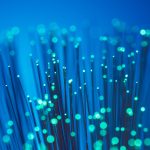
5 Advantages of Fiber Optic Internet Over 5G for the IoT
Many Internet of Things (IoT) devices connect wirelessly, but these devices can still perform better with the high speeds and relative stability of fiber optic internet. Here are five advantages of fiber internet over 5G for smart homes that have networked IoT devices.
1. Faster Home and Device Connections
All devices can benefit from the fast connection and symmetrical upload and download speeds of fiber internet. Some setup is necessary for a wireless home IoT network, including an optical network terminal to convert optic signals for delivery to a wireless router rated for gigabit speeds.
While many IoT devices do not require fast connections, this technology often performs best on consistent, secure, and stable connections. Fiber internet provides the most consistent speeds and smart home fiber network setups and can be very secure.
2. Stronger Network Security Options
Fiber optic strands do not radiate signals, which makes transmissions more difficult for third parties to intercept. Business users often use encryption systems for data, which are monitoring systems with sensors for physical cables that physically control access to systems.
Home users can implement any network security measures they deem necessary. Owners of businesses and/or smart homes who use many IoT devices should set up a strong network firewall.
3. A Reliable Hardwired Connection
Many IoT devices continuously measure recorded data for future reference in applications or user interfaces. Some devices may be able to temporarily back up data internally during network outages, however, storage capacity may be limited.
Fiber optic connections are not affected by electromagnetic interference or radio frequency interference like conventional copper cables. Fiber strands also transmit data without electrical signals, making fiber internet less susceptible to weather events than cell towers, conventional wired broadband cable, or DSL connections.
4. More Consistent Connection Speeds
Connection speeds on fiber range from 250 megabytes (Mbps) per second up to 1,000 Mbps or gigabit speeds. Fiber also offers symmetrical speeds for uploads and downloads, which is ideal for households whose members do a lot of video conferencing, gaming, or other bandwidth-intensive activities during which latency poses problems.
The average download speed range for conventional cable internet ranges from 10 Mbps up to 500 Mbps and is just 5 Mbps up to 50 Mbps for uploads. DSL is even slower, with download speeds up to 35 Mbps and a maximum upload speed of 10 Mbps.
5. Lower Ongoing Service Costs
Last mile labor, including the man-hours and resources necessary to lay lines, accounts for most of the initial cost of fiber internet. Based on the location of a residence, underground or aerial fiber connection methods may be available. The ongoing service-related costs of fiber internet are much less than 5G or satellite internet service plans.
Installing fiber optic internet is typically a costly proposition for end-users, but service costs for fiber connections tend to be lower than the total plan cost of connecting to cellular or satellite networks over time. V1 Fiber offers turnkey solutions for businesses running IoT networks that make fast fiber optic internet the clear choice.
Sources:
https://www.eff.org/deeplinks/2021/07/future-symmetrical-high-speed-internet-speeds
https://digitized.house/how-much-internet-speed-does-a-smart-home-need/
https://www.tinygreenpc.com/blog/optical-fibre-immune-to-electromagnetic-interference/
https://www.hp.com/us-en/shop/tech-takes/top-10-advantages-fiber-optic-internet-connections/
https://broadbandnow.com/guides/dsl-vs-cable-vs-fiber
https://arstechnica.com/tech-policy/2010/03/fiber-its-not-all-created-equal/





No Comments
Sorry, the comment form is closed at this time.